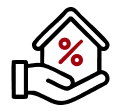Home Equity Loan Requirements: What Is Needed to Qualify?
KEY TAKEAWAYS
- Home equity loan and HELOC requirements vary by lender, but some common standards exist. Most HELOAN/HELOC lenders require a minimum credit score of 640 and want you to maintain at least 10-20% equity in your home after taking out the loan.
- You’ll need a steady income and a debt-to-income ratio of 50% or less to qualify for a HELOAN or HELOC.
- Alternative options like cash-out refinancing or personal loans might be worth considering if you don’t meet the requirements for home equity loan approval.



 Outstanding Client Experience
Outstanding Client Experience Specialized Lending Solutions
Specialized Lending Solutions Direct-to-Consumer Advantage
Direct-to-Consumer Advantage We're Advisors, NOT Salespeople
We're Advisors, NOT Salespeople Effortless Digital Mortgage Platform
Effortless Digital Mortgage PlatformTo tap into your home’s value, you should understand home equity loan requirements before contacting a lender. Whether you’re considering a traditional home equity loan (HELOAN) or a home equity line of credit (HELOC), being familiar with lender requirements can help you navigate the mortgage application process and improve your approval odds.
Keep reading to learn more about home equity loan requirements and what they mean for you.

KEY TAKEAWAYS
- Home equity loan and HELOC requirements vary by lender, but some common standards exist. Most HELOAN/HELOC lenders require a minimum credit score of 640 and want you to maintain at least 10-20% equity in your home after taking out the loan.
- You’ll need a steady income and a debt-to-income ratio of 50% or less to qualify for a HELOAN or HELOC.
- Alternative options like cash-out refinancing or personal loans might be worth considering if you don’t meet the requirements for home equity loan approval.
How Do Home Equity Loans and HELOCs Work?
Before diving into specific requirements, it’s important to understand how these lending options work. A home equity loan works similarly to your first mortgage, providing a lump sum that is repaid in fixed monthly installments. The only difference is that while your first mortgage could only be used to purchase the house, you can use a home equity loan for anything. A HELOAN is a second mortgage with a fixed interest rate and predictable payments.
Conversely, when you get a home equity line of credit (HELOC), you get access to a line of credit that you can pull from as needed during a set period, typically 10 years. While still a second mortgage, it’s more flexible than a traditional home equity loan since you can borrow what you need and pay interest only on the amount you’ve used.
The primary differences between a HELOC vs. home equity loan come down to how you receive and repay the money. With a fixed-rate HELOC, you can get the stability of consistent payments, while a standard HELOC typically has a variable rate that can change over time.
Both home equity loans and HELOC loans allow you to use the funds for anything, including debt consolidation, school costs, home repairs, or anything else you can think of.
Home Equity Loan and HELOC Requirements
Whether you’re applying for a home equity loan or exploring HELOC loan requirements, lenders will evaluate several key factors to determine your eligibility. Home equity loan and home equity line of credit requirements are essentially the same since they’re both secured by your home. Here’s what you need to know about qualifying:
Credit score requirements
Griffin Funding may approve borrowers with credit scores as low as 640. If you’re using the loan to tap into equity on an investment property, you’ll need a higher score of at least 680. Keep in mind that having a higher credit score helps you qualify for a better mortgage rate, meaning you’ll pay less in interest over the life of your loan.
If your credit isn’t where you’d like it to be, you can take steps to improve it before applying. Even a few months of positive credit activity can make a difference in your score and potentially help you qualify for better rates.
Home equity amount
Your tappable equity determines whether you qualify for a home equity loan and the total amount you can borrow. Most lenders require you to maintain 10-20% equity in your home after taking out the loan. This means if your home is worth $400,000, you’ll need to keep at least $40,000 to $80,000 in equity after borrowing.
In recent years, rising home values in many areas have increased homeowners’ available equity. In fact, Americans are currently sitting on more than $32 trillion in home equity, an all-time high. This means that a lot of opportunities exist to tap into that equity and access cash.
If you’re not sure about your home’s current value or available equity, you can start with an online estimate and then get an AVM or professional appraisal during the application process. Keep in mind that market conditions and home improvements can affect your home’s value and available equity.
DTI ratio
Your debt-to-income (DTI) ratio can be as high as 50% to qualify for a home equity loan. This means your total monthly debt payments, including your current mortgage, car loans, student loans, credit cards, and the new home equity loan payment, cannot exceed 50% of your gross (before taxes and deductions) monthly income. For example, if you make $8,000 per month before taxes, your total monthly debt payments should be no more than $4,000.
Before applying, calculate your current DTI ratio to see where you stand. If your ratio is too high, you might be able to lower it by paying down some existing debt or finding ways to increase your income before applying for a HELOAN or HELOC. Some borrowers choose to pay off high-interest credit cards with their home equity loan, which can actually improve their DTI ratio in the long run.
Employment and income
You’ll need to prove you have a steady income sufficient to repay the loan. Lenders typically want to see:
- At least two years of consistent employment
- Reliable income sources
- Tax returns and W-2s from the past two years
- Recent pay stubs
If you’re self-employed, own a business, or are retired, you can still qualify for a home equity loan. Griffin Funding offers flexible options like no-doc home equity loans that look at alternative ways to verify your income. These loan programs can be especially helpful if you have non-traditional income sources or prefer not to provide standard documentation.
Property appraisal
To qualify for a HELOAN or HELOC loan, the lender will need to determine how much your house is worth. This helps lenders calculate your available equity and determine your loan-to-value ratio, which affects how much you can borrow. Most lenders will arrange the appraisal for you as part of the application progress. The appraisal fee is typically included in your closing costs. A full property appraisal may not be required if the lender can determine the value of your property with an Automated Valuation Model (AVM) and a Property Conditional Report (PCR) – streamlining the home equity process.
The higher your home’s appraised value, the more you might qualify for. To ensure the appraisal is accurate, make sure your home is well-maintained and consider making any minor repairs beforehand. Keep records of any significant improvements you’ve made to the property, as these can impact its value.

Alternatives to Home Equity Loans
If you don’t meet the home equity loan requirements but still need access to cash, there are several alternatives worth considering:
- Cash-out refinance: You might choose to refinance your mortgage with a cash-out option if you don’t qualify for a HELOAN or HELOC but still want to take advantage of the value of your home. Unlike a HELOAN or HELOC, which are second mortgages, this loan replaces your current mortgage with a larger one, giving you the difference in cash. A cash-out refinance can be especially helpful if you can secure a lower interest rate than your current mortgage. However, even if that’s not the case, it still might make sense if you need to consolidate debt or pay for a major expense with a lower interest rate and single monthly payment.
- Personal loans: While they typically come with higher interest rates, personal loans don’t require using your home as collateral. They might be a good option if you need a smaller amount or want to avoid putting your home at risk.
- Reverse mortgage: These loans are only available for homeowners over the age of 62. Reverse mortgages provide access to home equity without monthly payments. However, this option comes with its own specific requirements and considerations.
See If You Meet the Requirements for a Home Equity Loan
A home equity or HELOC loan can be a smart way to fund major expenses while securing lower interest rates compared to personal loans or credit cards. Plus, the interest you pay may be tax-deductible when you use the money for home improvements.
Griffin Funding is here to help you understand and navigate the application process. Our experienced mortgage experts can walk you through the home equity loan or HELOC requirements and help you choose the best option for your needs.
We also offer free tools that make it easy to review your mortgage options. The Griffin Gold app can help you check your eligibility and compare different home equity solutions. Our platform streamlines the application process and helps you understand exactly what you need to qualify.
Ready to explore your options? Reach out today and connect with one of our mortgage professionals to find out how you can best leverage your tappable equity to achieve your financial goals.
Find the best loan for you. Reach out today!
Get StartedFrequently Asked Questions
What disqualifies you from getting a home equity loan? 
Is it hard to get a home equity loan? 
Working with an experienced home loan lender who can guide you through each step makes the whole process smoother. In addition to traditional home equity loans and HELOCs, we also offer self-employed home equity loans with alternative income verification methods.
How much can I borrow with a home equity loan? 
For example, if your home is worth $800,000 and you owe $400,000 on your mortgage, you might be able to borrow $320,000 or more.
Recent Posts
Down Payment Calculator
Planning to buy a home? One of the biggest questions you’ll face is figuring out how much cash you need ...
No Capital Gains Tax on Home Sales Legislation: What to Know
The current tax structure creates challenges for homeowners who have seen their property values soar over rece...
Bank Statement Loan Document Checklist
The main difference between bank statement loans and conventional mortgages is how your income is verified. Tr...









